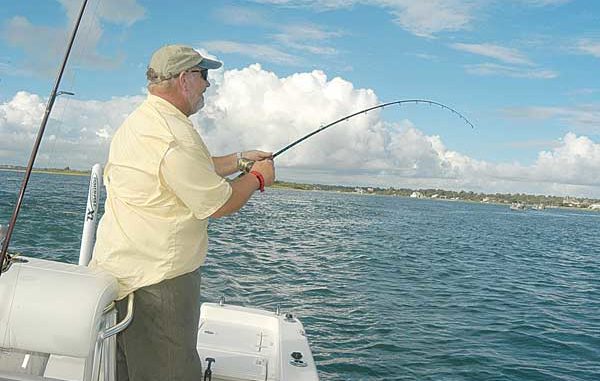
Migrating flounder give Carolina Beach fishermen a great fall outlook.
Like snowbirds heading south for the winter, flounder start a similar fall migration this month at the Carolina Beach area.
Like the big boats from New Jersey, New York, Connecticut and Rhode Island headed to Florida, flounder clog the ICW, the inlets and Snow’s Cut — but at least they don’t push out ridiculous wakes or wear dark socks with sandals.
And the locals, especially: Rick Bennett and Ricky Schoonmaker, are glad to see them.
The two inshore captains never would call flounder “easy” — especially compared to puppy drum, speckled trout and bluefish — but they never complain about the big, mottled brown doormats that set up shop around Carolina Beach Inlet, the ICW, the mouth of saltwater creeks, at either end of Snow’s Cut, in the Cape Fear River or later in the fall at nearshore rocks and reefs.
“The fish are really stacked up inshore; it’s big-fish time around all of those places,” said Bennett, who operates Rodman Charters out of Wrightsville Beach but spends most of his fishing time in the Carolina Beach area. “They’re starting to move towards the ocean — on their way to the continental shelf where they’ll spawn over the winter, and you’ve got new fish moving into different areas, replenishing them as other fish move out.
“The quality of the fish improves as you go deeper into the fall. There are more double-digit fish probably caught in October and early November than any other time of the year.”
Bennett (910-799-6120), whose charter service is named after his custom rod-making business, loves the thought of trying to fool a big flatfish several times a day. Ditto Schoonmaker, who agreed that fishing tactics and techniques are pretty elementary — right down to the know-how that puts fish in the boat.
“Anybody can catch a trout or a puppy drum,” said Schoonmaker (910-624-1807), who operates Carolina Explorer Charters from his home base in Carolina Beach. “They’re so aggressive, they just about commit suicide when they bite. But a flounder, that’s a challenging fish to catch.
“A flounder will sometimes mouth a bait and play with it before he swallows it, and most people aren’t patient enough to wait before they set the hook.”
The southern flounder that comprise a great majority of the flounder fishery along the Cape Fear coast are headed to the ocean as the water temperature drops inshore, in the creeks and marshes and holes and ditches they’ve called home since Memorial Day. The closer they live to Carolina Beach Inlet or Masonboro Inlet, the faster they get to the ocean. The farther way, the longer it takes. That guarantees a good two months of fishing at those places they stop along the way.
Those areas usually have a few things in common. Bennett and Schoonmaker agreed a pretty severe depth change is in order, so steep ledges and drop-offs get a vote. Places with lots of cover — some fishermen call it “structure,” but it’s really junk on the bottom — also attract flounder; they use them as ambush points. And places with a good bit of current are also prime.
Put those three factors together and you’ve got Snow’s Cut — the man-made barge channel that joins the Cape Fear River with Myrtle Grove Sound — Carolina Beach Inlet and a handful of spots along the ICW.
A handful of really good drop-offs exist at the inlet, on the ocean side and ICW side. Dredging has created some drops, and the natural rush of the current has cleaned out some holes, not to mention the natural features that occur when two deep channels meet. The inlet is usually Bennett’s first stop, especially if he can fish it during a tide change, especially from rising to slack high to slightly falling.
“Typically, the best action is on an incoming tide and the first part of the falling tide; they just bite better,” said Bennett. “I like to anchor up over shallow water and cast into deeper water. I fish mostly ledges and drops. I like to sit on top, throw out into deeper water and drag my bait back up the drop.
“I like to fan-cast; I don’t want to work one area over and over. I’ll cast to different places until I catch a fish, then I want to throw right back where I caught the first one because there may be others in the general vicinity. If you can find a small place they’re using, it’s on. I pulled up to one spot one morning, and my party made six casts and caught five 5-pounders. All of them came out of a space 20-feet wide.”
Bennett and Schoonmaker both fish a basic Carolina rig. The business end is a Kahle-style live-bait hook — Bennett likes a No. 2 Eagle Claw 042. That’s tied to a monofilament leader between 12 and 18 inches long; Bennett likes 25-pound test, Schoonmaker 50-pound test. The leader is tied to a No. 10 barrel swivel, above which an egg sinker between one-half and 1 1/2 ounces is threaded onto the running line. A 6 1/2- to 7-foot, medium-light to medium-action rod is the ticket, with an appropriate reel.
“I use just about what everybody else is using,” Schoonmaker said. “It’s no great secret. We all use just about the same thing, and we’re all fishing drop-offs and structure.”
Schoonmaker said he alternates between sitting shallow and casting deep and sitting deep and casting shallow. He might change on a daily basis — or on a whim.
“I’ll sit shallow and throw deep or sit deep and throw shallow; everybody is different the way they do it,” he said. “One day you might cast deep and catch ’em; the next day somebody might cast up on a sand bar and catch one, and you all turn around and throw shallow.”
Bennett and Schoonmaker agree anglers barely should move baits every so slightly, using the rod tip to drag the egg sinker a few inches at a time, keeping the bait within a few inches of the bottom — where flounder are flattened, hiding in the sand or silt, waiting for the current to sweep a bit of food past their jaws.
“Around the inlet, I’ll fish an incoming tide around places where I think the tide will wash bait past fish,” Bennett said. “When the tide changes, I’ll move in the opposite direction.
“I think the places you fish are spots where bait is being swept by the current past potential predators, including flounder. If you think about it, you just kind of move around the corner when the tide changes. It’s natural for flounder to be facing the way the bait will be swimming — with the current.”
The current plays an even bigger part fishing at Snow’s Cut because it’s normally moving at a pretty good clip, and because anglers can move from the Carolina Beach end of the cut to the river end of the cut in a matter of minutes.
Finger mullet, menhaden and mullet minnows are the live-bait tickets. Bennett said he prefers menhaden but will use “whatever’s the easiest to catch” the morning of a trip. He’s not averse to using fairly large baits, knowing that “a 3-pound flounder can eat a 6-inch (menhaden) easy.”
The only difference in the way different baits are fished has to do with how long Bennett or Schoonmaker wait before setting the hook after a flounder starts tapping their lines.
A fisherman who comes up with an always-perfect way to determine when to set the hook could probably win the lottery on a weekly basis or break the bank in Las Vegas playing blackjack.
“How long I wait before setting the hook is sort of based on the size of the bait I’m fishing,” Bennett said. “If I’m fishing a 3-inch bait, I might wait 30 or 40 seconds after I first feel him. If I’m fishing a 6-inch bait, I might wait an 80- to 100-count. And I like to err on the side of waiting too long, because once he gets the hook down his throat, you’re going to catch him anyway. A lot of times, when one hits, I’ll open the (reel’s) bail and feed him line. You don’t want him to know you’re there.”
When Bennett and Schoonmaker move to Snow’s Cut, they fish spots along the channel drop-off, setting up according to the current.
“I like to anchor up on the shallow flats and cast to the drop-offs,” Bennett said. “If the tide is incoming, it’s running into the river. If it’s outgoing, it’s going toward the inlet. I like to fish on the south side of the cut most of the time, because it’s got more good structure and better drop-offs.
“I’ll fish opposite ends depending on the tide, but I’m more likely just to fish the other sides of any obstacles or abutments — big rocks, logs, stuff they’ll be laying behind. On an incoming tide, I’ll be fishing the river end, and on the outgoing tide, I’ll be fishing the Carolina Beach end. The fish will change positions as the tide changes.”
“A lot of it is timing in the Cut,” Schoonmaker said. “You’ve only got an hour-and-a-half or two hours, right at the end of the tide, right before slack and right after. That way, the current is not running so hard that you get hung up all the time. And that’s a real snaggy place.
Besides Snow’s Cut and Carolina Beach Inlet, Schoonmaker will look for fish around the mouths of saltwater creeks on a falling tide, knowing that nearly all predator fish will set up there to wait for baitfish and shrimp to be pulled out of the marsh grass.
“If you’re fishing the waterway and the creeks, the falling tide seems to be better,” he said.
Later in the fall, Bennett will start catching flounder in the ocean, at nearshore rocks and reefs — but most often accidentally as he typically targets gray trout at those areas. But the situation is the same: flounder will be at depth changes near bottom contours, waiting for food to pass their way.
Flounder typically flatten themselves against the bottom, wriggling around, hoping to cover their edges or much of their backs with sand or silt from the bottom — not to mention using their great, natural camouflaged colors. When a baitfish is swept past, the flounder surges off the bottom and grabs the minnow, often by the tail or midsection. Next, with teeth holding tight, it slowly works its way up the body of the baitfish or turns it head first to take it down its gullet. Finally, it swallows the bait, often moving away slightly.
A flounder’s bite may be a single “thump” when it first grabs the minnow, followed by a series of weak “taps” as it grabs and re-grabs the bait, sucking it down. Then the fish may just feel “heavy” on the rod, perhaps before moving off a few inches when its meal is eaten.
Figuring out what the thumps and taps are on a consistent basis may separate flounder-fishing experts from wannabes.
“I’ll wait a little longer to set the hook if I’m fishing a bigger bait, but it also depends on the bite,” Schoonmaker said. “If he’s real aggressive and really pops it, I won’t wait too long. If he’s one of those fish where you just feel a series of light taps, then he just sort of hangs on, I’ll wait the longest time. The old saying down here is ‘You get a bite, you drink a beer, you set the hook.’ ”
Setting the hook too early will result in your pulling back no baitfish, a baitfish with a missing tail, or a baitfish that Bennett said “looks like it’s been through a shredder.”
However, when an angler waits the correct amount of time, he might get a big reward. Bennett said it’s rare that one of his parties boats a flounder that doesn’t make the 14-inch size minimum — or even one close enough to measure.
“One of the greatest things about flounder fishing in New Hanover County is that we see very few juvenile fish — just about every fish we catch is a keeper,” he said. “We have one of the best estuary systems for flounder. It’s not big, but it’s perfect for flounder — lots of drop-offs and structure, and because of the Cape Fear River, it’s very rich in nutrients. It’s just super habitat for flounder.”
Schoonmaker said there’s another factor — dingy water.
“I think one reason we’ve got so many flounder is the color of the water,” he said. “Around Carolina Beach, it’s dirty enough that it’s not productive to gig. You get up around Wrightsville Beach and Figure Eight Island, and the water is so clear everybody and his brother is gigging. There aren’t many giggers around Carolina Beach.”

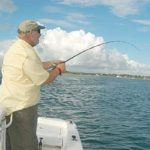
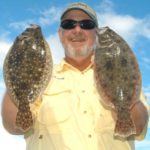

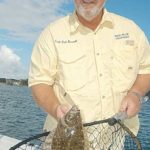
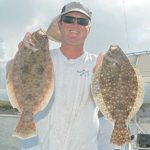
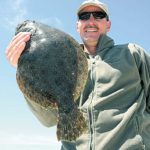




Be the first to comment